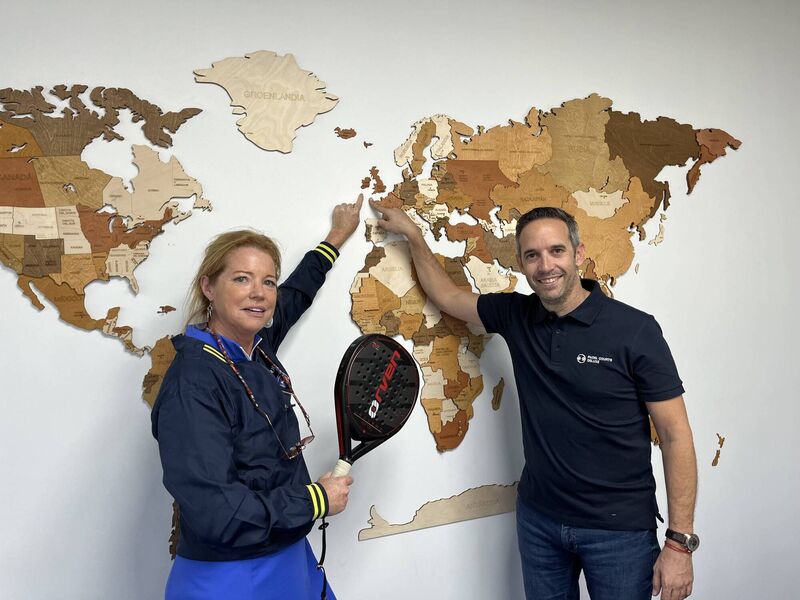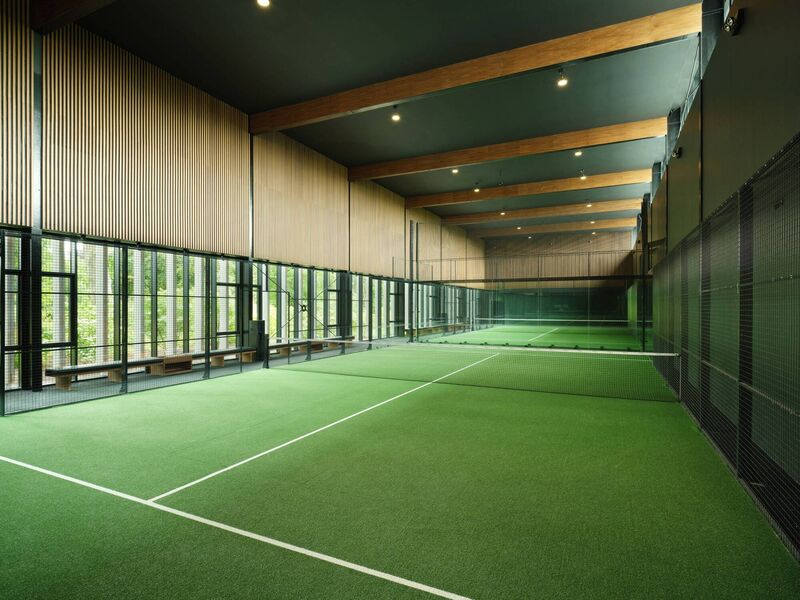At 49, Douglas Oldrey was fairly sure that his chances of representing Ireland in any sport had probably long since passed him by. Yet last month, the Dubliner walked out behind the tricolour as organisers of this year’s Spanish Padel Masters tournament announced Team Ireland on to the court.
“We sent 16 men and 12 women out,” says the international. “It was a great experience to represent Ireland at vets level. I’m nearly 50 and never thought I’d be representing my country at this stage in life.”
The Wexford native started Padel in 2018 when he came across the small courts mid-construction in a local park in Dublin where he now lives. “When they were building the courts there in Bushy Park in Terenure, I remember seeing them for the first time and thinking that someone had made a mistake. But then I found out about the game, and myself and a neighbour decided we’d give it a shot.”
Having played both tennis and squash socially, Douglas had the necessary racquet skills to get with the basics of the game straight off the bat… or should that be Padel. He was soon hooked and says he now plays at least “three or four times a week on a good week”.
“It’s a doubles sport really, you always need a partner,” says Douglas.
“Tennis players who play Padel tend to be better at the net and squash players know how to use the glass at the back of the court. It’s the social aspect of Padel and teamwork that I like. Having to play and work with a partner adds a different dynamic to it. With squash, you’re on your own and I think, with tennis, you need to be at a higher standard to get decent rallies going. With Padel you build that up a bit quicker, so you get to enjoy it sooner in a way. You get to play rallies much faster in Padel.”
It is thought that the sport started in Mexico in 1969 when a certain Enrique Corcuera constructed a mini tennis court in his small garden. Frustrated by the fact that the balls kept falling into his bushes, he built walls around the court to keep them in.
It is thought that a Spanish friend of his who played the game brought it back to his local club in Marbella where he built two courts and cast the die for what would become one of Spain’s most popular sports with now more than 6m players.
Unsurprisingly, the Spaniards remain kings and queens of the sport on the global stage, though others have caught up.
“In Spain, it’s at a very high level,” says Douglas. “They’ve been at it longer. But if we look at Sweden, as an example of what can happen, they had no Padel in 2018, they invested massively and now they have 500,000 players and their national teams are close to the top. So it’s like any sport, it needs investment. It’s in its infancy here.”

CEO of PCI Yvonne Dolan with business partner Fernando Canovas of Padel Deluxe
It is growing, however, and, in ways, the game has become a victim of its own success. Demand for courts has shot up and there simply aren’t enough. Bushy Park, the home of the Padel Federation of Ireland, currently has a wait time of two weeks to book a slot on one of its four courts.
“When the federation was accepted into the international federation in 2018, Padel was starting to take off, and then covid came along,” says the president of the federation, Naomi Nicholl. “Of course, there were benefits because people got out and started seeing the game and playing, but in terms of infrastructure, it essentially stopped. So people and clubs we were in touch with before the pandemic about putting courts in and getting accreditation put a hold on their Padel projects and in some cases ended up going in different directions. We are seeing an increase in interest again though.”
According to Naomi, there are around 6,000 players in Ireland. In the early years, interest was concentrated in the suburbs of Dublin but the game is starting to move out of the capital. In recent months, courts have popped up in Cavan, Kildare, Waterford, Wexford, Bangor, and Enniskillen and construction is underway for at least one at a private club in Cork. Hotels including Kelly’s Hotel, Rosslare, and Woodlands Hotel and Adare Manor, Co Limerick, have installed Padel courts with one at Fitzpatrick Castle Hotel in Killiney under construction.
“I think the social aspect of the game is really important,” says Naomi. “And it’s probably the main reason it is so popular. Our coaches would say that it’s a very generous sport too in that you get out of it what you put into it. People can learn it quite quickly and get quite good at it if they put in the work. We have a lot of disability groups that come to play.
“Because it’s enclosed, there’s glass, and the court is smaller than tennis, it’s quite achievable. It’s less of a daunting sport.”
Yvonne Dolan, CEO of Padel Courts Ireland, echoes that assertion and says that Padel is far less technical than either tennis or squash. “It’s very easy to walk onto a court young or old and pick it up very quickly and have fun,” she says. “It’s a smaller court, you don’t have to move around as much, so you don’t have to be as fit. The smaller court makes it more sociable because you can chat and have a laugh as the point is taking place.”
Yvonne came across the sport while living in Spain where she spent the best part of seven years. A fine golfer with a low handicap, she found “the fun” of Padel more attractive the more she played it.
“I had never played a game where I came away laughing all the time. The minute I came off the court, I’d book for the next game straight away.”
On her return home, she took up tennis but soon discovered that the game she had grown to love was now in Dublin. She never thought she would eventually make a business out of it. “I am an entrepreneur, my background was in food startups. A friend of mine asked me if I could help her build a Padel court in her garden. I didn’t know where to start but I had time on my hands, went over to Spain, and visited some Padel manufacturing companies.”
Eventually, Yvonne struck a deal with one of Spain’s premier providers. The provider travelled to Ireland and supported Yvonne in the construction of the company’s first two Padel courts. After the success of those, more orders began to roll in. The company has now constructed courts across the country in hotels, private homes, and a community centre.
“It’s great to see clubs adding courts and independent clubs being set up,” says Naomi. “Irish players and teams are training hard. The federation sent a team of four, two men and two women, to compete with Team Ireland at the European Games in Krakow earlier this year. Last year, we hosted the qualifiers for the 2022 World Padel Competition in Bushy Park with nine other international teams being represented from across Europe. So we are growing, getting more involved on the international scene, and we are improving. The level has definitely gone up which is great to see.”

Adare Manor padel court
1. Padel is most often played in doubles.
2. A normal padel court is designed for four players and is roughly 25-30% smaller than a tennis court.
3. Padel rules are similar to those of tennis, but you serve underarm.
4. Points are calculated the same as in tennis with points, games, and sets. At deuce, you go straight to a ‘golden point’ where the winner of the point wins the game. Like tennis, the game uses a tiebreak to separate teams at 6-6.
5. Padel balls are smaller and have less air pressure than tennis balls
Comments
0 comments
Please sign in to leave a comment.